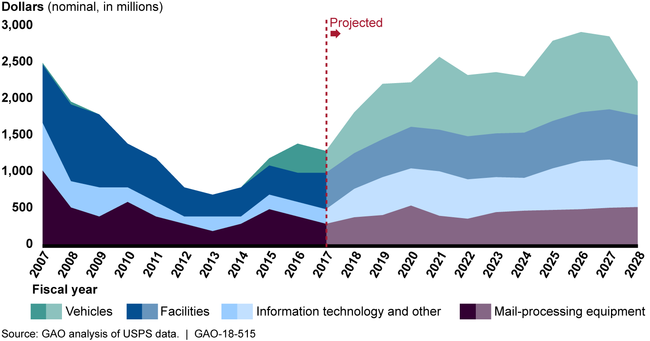U.S. Postal Service: Projected Capital Spending and Processes for Addressing Uncertainties and Risks
Fast Facts
USPS faces unsustainable financial challenges. It was structured to be self-supporting but First-Class Mail volume continues to drop and it has seen operating losses for 11 straight years.
After years of reduced capital spending, USPS says it has critical capital spending needs. For example, to help it meet its statutory obligation for prompt, efficient and reliable services, it plans to replace delivery vehicles—most of which are decades old.
We found that USPS has processes in place to help it identify the uncertainties that may affect its capital spending plan, and flexibilities that allow it to adjust the plan accordingly.
U.S. Postal Service Historical (2007-2017) and Projected (2018-2028) Capital Spending

USPS plans to increase its capital spending by approximately 70 percent over the next decade.
Highlights
What GAO Found
The United States Postal Service (USPS) projects increased capital spending over the next 10 years. According to USPS, this spending will support its mission and improve its financial position. USPS projects average annual capital cash outlays of $2.4 billion from fiscal years 2018–2028—about 70 percent more than the $1.4 billion average from fiscal years 2007–2017 (see figure). For example, USPS plans to acquire a new fleet of delivery vehicles starting in 2019 to replace its aging existing fleet and plans to purchase new mail-processing equipment to increase efficiency. However, USPS faces a serious financial situation with insufficient revenues to cover expenses. This uncertainty may result in USPS's making capital-spending prioritization decisions that can lead to tradeoffs across planned capital projects and potentially between capital spending and other organizational needs such as operational expenses. Such prioritization could lead to USPS's undertaking less capital spending than currently projected in the absence of increased revenues or decreased expenses.
U.S. Postal Service's Historical (2007–2017) and Projected (2018–2028) Capital Spending

USPS has processes that help it identify the uncertainties and risks that may affect its capital spending and adjusts its capital spending accordingly, in line with internal control standards adopted by USPS. For example, USPS identifies organizational uncertainties, such as mail volumes and revenues, as part of its strategic planning process and considers them when creating its capital spending budget. It also identifies individual project risks through a project review process, and considers tradeoffs inherent in different project scenarios. USPS's processes also allow it to respond to these uncertainties and risks. Specifically, USPS sets a capital-spending budget in its overall financial plan, to help ensure that spending is in line with expected resources. USPS's process also allows it to shift funds if needed, such as to repair a facility damaged during a natural disaster. USPS also reviews individual capital projects during implementation and can change specifications or time frames based on changing circumstances.
Why GAO Did This Study
USPS faces significant financial challenges as it continues to experience declining mail volumes and revenues. Capital spending is needed to support USPS's operations, but can be affected by various uncertainties and risks, such as those related to future business activities and revenues. In the past, USPS has reduced its capital spending in response to declining revenues.
GAO was asked to review USPS's capital-spending plans and examine how its capital-spending processes address uncertainties and risks. This report: (1) describes USPS's projected capital spending over the next 10 years and (2) assesses whether USPS's processes support its ability to address uncertainties and risks that affect its capital spending.
GAO reviewed USPS data and information on actual capital spending from fiscal years 2007 to 2017 and projected capital spending for fiscal years 2018 through 2028. GAO also reviewed USPS reports on 14 approved capital projects in fiscal years 2017 and 2018, selected to provide a mix of project type and value; examined documentation related to USPS's processes that affect capital spending and compared USPS's processes to internal control standards adopted by USPS; and interviewed USPS officials.
On a draft of this report, USPS provided technical comments, which GAO incorporated as appropriate.
For more information, contact Lori Rectanus at (202) 512-2834 or rectanusl@gao.gov.
